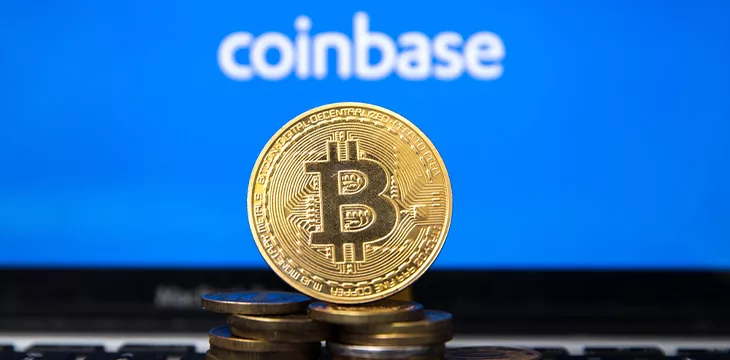|
Getting your Trinity Audio player ready...
|
In the wake of the much-anticipated launch of spot BTC exchange traded funds (ETFs) in the United States, the country’s largest digital asset exchange, Coinbase (NASDAQ: COIN), finds itself at a crossroads, with investors and observers questioning what impact the product will have on the company.
This March, BTC reached a new all-time high of $71,800 as investors piled in before an April halving—a periodic event aimed at reducing the number of new coins being distributed into circulation. The boom appears to show a return to investor confidence for the industry, or at least for BTC, after high-profile collapses and scandals of 2023.
This new found optimism was reflected in—or possibly inspired by—the passing of 11 spot BTC Exchange-Traded Funds (ETF) by the U.S. Securities and Exchange Commission (SEC) on January 10. After much resistance and wrangling, SEC Chairman Gary Gensler gave the long-awaited ETFs the green light, paving the way for BTC to jump to new heights.
The recent bull market has also caused a surge in interest in the digital asset space that leading exchanges have been struggling to handle. One notable example is Coinbase, which experienced several concerning outages and technical issues in February and March after BTC breached $60,000 for the first time in two years.
The largest digital asset exchange in the U.S. is never far from the news when BTC is concerned, and the spot BTC ETFs were no exception, with Coinbase claiming custodianship for eight of the 11 new funds—a custodian is entrusted with safeguarding the BTC holdings of spot BTC ETF providers.
Being up to its elbows in the ETF business while BTC prices soar, Ethereum advocates
already clamor for their own ETFs, should imply that Coinbase is living through its halcyon days. Yet things are not all moonlight and roses for the exchange.
Coinbase is coming off the back of a 2023 that saw it fined over $56 million dollars by various regulators, and it is currently dealing with SEC charges related to alleged illegal securities sales.
While the approval of spot BTC ETFs might seem, on the surface, to be an obvious win for Coinbase, when examined under the microscope, these new products could end up being more trouble than they’re worth for the embattled exchange—literally.
But before digging into the new products’ effect on its custodian-in-chief and the digital asset market more broadly, it’s worth clarifying what this new product is and why the SEC was reluctant to give its approval.
Spot BTC ETFs and the SEC’s reluctance
An ETF is a specific type of Exchange-Traded Product (ETP). While all ETFs are ETPs, not all ETPs are ETFs. ETP is a broader category that includes various products like exchange-traded notes, exchange-traded commodities, and ETFs, representing investment funds traded on exchanges.
A BTC ETF tracks the price of BTC, but up until recently, these types of funds didn’t actually hold BTC. They held BTC futures contracts—legal agreements to buy or sell particular assets at a predetermined price at a specified time in the future—or invested in companies involved in BTC-related activities, such as mining or trading.
In contrast, “a spot BTC ETF is an ETF that holds BTC,” says Violeta Todorova, Senior Research Analyst at Leverage Shares, describing its company as a European firm specializing in leveraged and inverse ETPs. She explains that “investors buy and sell shares of the ETF on a stock exchange gaining exposure to BTC price movements. The ETF performance follows BTC prices closely, minus fees.”
These products provide investors a way to gain exposure to BTC without needing to directly purchase and store it themselves and allow investors to buy and sell shares of the ETF on traditional stock exchanges, providing ease of trading.
Speaking with CoinGeek, Todorova suggests spot BTC ETFs appeal to investors “not willing to transact on a decentralized crypto currency exchange and have a digital wallet.”
This is likely a significant number of investors, both private and institutional, given the bad press the digital asset industry and decentralized finance have faced over the past few years.
BTC futures ETFs have been on the market for a while, but the SEC was reluctant to wave through the rule changes required for a spot BTC ETF to be sold. The SEC’s initial reluctance was primarily based on market manipulation, price volatility, and investor protection.
The SEC has made no secret about its belief that the digital asset space, BTC included, lacks the same level of regulatory compliance as traditional financial markets. Manipulative activities such as wash trading, price manipulation, insider trading, and fraud could all potentially impact the value of a spot BTC ETF.
These practices and scandals exacerbate the already notorious volatility of BTC. One only needs to look to the highs and lows of the last two years for evidence. Such erratic price swings would naturally impact spot BTC ETFs and investors’ holdings. This leads to the third major issue, protecting investors—a primary mandate of the SEC.
The regulator was cautious about approving products tied to highly speculative and largely unregulated assets like BTC, especially considering the potential for retail investors to suffer losses due to a lack of understanding or exposure to a complex product.
Speaking in December 2023, a few weeks before the first ETFs were approved, SEC chair Gary Gensler said:
“There’s been far too much fraud and bad actors in the crypto field. There’s a lot of noncompliance, not only with the securities laws but other laws around any money laundering and protecting the public against bad actors there. And so I would note, this is a field where you still don’t have the fundamental information on many of these projects. And the intermediaries of the so-called crypto exchanges are commingling and doing things that we do not allow anywhere else in our financial system.”
Gensler’s comments also point to a fourth concern the regulator had when considering spot BTC ETF approval: the questionable practices of the entities that would act as custodians for the proposed ETFs, chief amongst them the SEC’s perennial sparring partner Coinbase.
Three’s company for Coinbase, SEC, and ETFs
The SEC requires that ETFs have proper custodial arrangements to ensure the safekeeping of assets, and custody solutions for BTC have been a point of contention. The SEC wanted assurance that the BTC held by the ETF would be adequately protected against theft and hacking, given the history of security breaches and thefts in the digital asset space.
Coinbase, being the largest registered exchange in the U.S., was always likely to be the natural custodian of most spot BTC ETFs when approved. So it’s no surprise the SEC was hesitant about rubber stamping the products, knowing they’re the primary custodian of a company in which it’s fair to say the regulator does not have a great deal of confidence—and for good reason.
In 2021, Coinbase was ordered to pay a $6.5 million fine to the Commodity Futures Trading Commission (CFTC) for false, misleading, or inaccurate reporting and wash trading. According to the SEC, between 2015 and 2018, the platform had recklessly delivered false reports concerning BTC transactions on its platform and was operating two automated trading accounts that traded against one another on the Coinbase platform.
In January 2023, Coinbase was forced to pay a $50 million fine to the New York Department of Financial Services (NYDFS). The New York financial regulator discovered that Coinbase had violated anti-money laundering laws by allowing customers to open accounts on the platform without being subjected to identity and background checks. Coinbase was also forced to invest $50 million in building out its poorly functioning compliance program.
The icing on the cake came in June 2023, when the SEC filed long-anticipated
charges against the company for operating an unregistered national securities exchange, broker, and clearing agency, as well as for failing to register its digital asset staking program as a securities offering.
Yet things could still go from bad to worse for Coinbase. Based on the SEC’s view of digital asset securities, it’s been predicted that 37% of Coinbase’s net revenue is potentially at risk of vanishing if the SEC succeeds in its case.
“The legal battle between Coinbase and the SEC is closely watched as it has far more reaching implications beyond Coinbase, and its outcome would affect the entire crypto industry,” suggests Todorova.
“In the case of an adverse ruling, Coinbase would face significant operational challenges as it will have to restructure its multifaceted functions of exchange, broker, and clearinghouse, which in security markets are separate businesses. If the SEC’s demands are granted, Coinbase could lose a big chunk of its revenue.”
This potential loss in revenue made the go-to custodian for the majority of the approved spot BTC ETFs appear to be an unsafe pair of hands with which to entrust this shiny new product—particularly from the perspective of the SEC.
However, in the end, it seemed the regulator could not continue delaying its decision or adequately justify a flat-out refusal. In January this year, the SEC finally relented to the clamor for spot BTC ETFs and approved eleven funds.
Effect on the market
Despite the enthusiasm for the new product, the post-approval impact on the market and on BTC itself was somewhat underwhelming.
“[BTC] dropped more than 20% from the day of the approval, declining from a high of $48,750 to a low of $38,572 posted on the 23rd of January,” points out Todorova.
This would have proved deflating for any BTC advocates expecting its price to go through the roof thanks to the likes of BlackRock and Invesco (both asset managers had funds amongst the first approved: iShares BTC Trust and Invesco Galaxy BTC ETF, respectively).
However, Todorova suggests this muted reaction is not wholly unexpected:
“We assign such decline to the massive rally prior to the SEC approval, and we see it as a normal ‘buy the rumor, sell the news’ behavior. We are expecting a gradual recovery to take place and we envisage significantly higher prices for [BTC] in the year ahead.”
In the end, the market only had to wait until March for the significantly higher BTC prices Todorova anticipated, with the asset reaching a new all-time high of $69,000 on March 5.
But what goes up must come down, and with a BTC ‘halving’ coming in April—where the reward for mining new blocks is halved, meaning miners receive 50% fewer BTC for verifying transactions—it’s not surprising to see a flurry of investment in March. Whether it also has anything to do with the spot BTC ETFs, “it is far too early to tell,” says Todorova.
“As a new asset class spot, BTC ETFs will undergo stringent due diligence and compliance before big financial institutions start to recommend them to clients. While investors’ interest toward spot BTC ETFs is starting to slow, nonetheless the spot BTC ETFs launch is still considered one of the most successful by trading volume and flows.”
Perhaps, then, it’s a matter of expectations and perspective. The early ETF inflows were dominated by retail traders, which, according to Todorova, “are starting to subside.” Once investment banks and large brokerage companies onboard the new ETFs, the inflows could increase drastically throughout 2024.
If such rosy predictions come to pass, how would it impact the trendy new product’s primary custodian?
The spot ETF paradox for Coinbase
Despite its hefty 2023 fines, run-ins with regulators, and—depending on the outcome of its battle with the SEC—a potential future drop in net revenue of up to 37%, Coinbase miraculously seems to have avoided scaring off investors.
Bizarrely, the exchange was one of the best-performing stocks of 2023. Coinbase’s price started in 2023 at $43.85. By December, it was trading at $146.62. A price increase of 234% from the beginning of the year.
“The business was recording strong financial results amid a huge rally in crypto assets and anticipation of the launch of the spot BTC ETFs,” says Todorova. However, she points out that from the start of 2024, the company’s share price took a hit, declining to its lowest point on the 19th of January.
This decline mirrors the post-spot BTC ETF approval drop in the price of BTC, hinting at an unfortunate paradox at the heart of Coinbase’s custodianship of the new product.
“The spot BTC ETFs launch was the main catalyst driving cryptocurrencies and Coinbase share price significantly higher in the second half of 2023. However, Coinbase share price has fallen 27% since spot BTC ETFs were approved. Most of the spot BTC ETFs, which were launched on the 11th of January, have attracted strong investor interest and have registered big inflows,” explains Todorova.
“Before the 11th of January, investors could only gain exposure to BTC by directly purchasing the cryptocurrency on an exchange like Coinbase. Now investors can buy shares of the new spot BTC ETFs through traditional brokers, raising concerns that Coinbase could lose some of its sources of income.”
Unpacking this a bit. The margins from custody are thin. Coinbase only receives a 0.2% fee for its custody services. For context, the platform’s trading commission charges to customers every time they buy or sell can be up to 0.6%.
Trading fees still make up the majority of Coinbase’s revenue. In 2023, transaction revenue accounted for almost 50% of the company’s total revenue (just over $1.5 billion), while custodial fee revenue accounted for only around 2% ($69 million).
Since the spot BTC ETFs launch on January 11, total net inflows (in the market) are estimated at $7.5 billion. Coinbase, the custodian for the majority of these funds, is sure to increase its revenue for custodial fees substantially in Q1 of 2024.
However, the concern for the exchange is that the rise of low-cost spot BTC ETFs gives investors a cheaper, easier, and what many will view as a safer route to trade BTC, the most widely traded asset on the platform and in the digital asset space in general.
“Most of the spot BTC ETFs offer fees lower than 0.4%, while Coinbase charges between 1.5% to 4%. Therefore, investors may prefer to gain exposure to BTC via an ETF, which could cause Coinbase’s revenue from BTC transactions to decline. BTC transaction fees are around 17% of Coinbase’s total revenue,” says Todorova.
In other words, a volume drop in Coinbase’s more profitable BTC trading business could quickly offset any gains made from its ETF custody.
The future for Coinbase and spot BTC ETFs
On the face of it, if more ETF issuers are approved—regardless of whether Coinbase is named custodian—trading volume will almost certainly continue to slide in favor of the new product. It’s also likely that Coinbase will face increased competition for market share of custodian duties from rival exchanges. This means it could face a drop in net revenue in the foreseeable future.
Todorova, however, sees a more optimistic road ahead for Coinbase:
“While it is difficult to quantify the impact of the spot BTC ETFs on Coinbase’s revenue in the early days of their listing, over the long-term, the company is likely to be a beneficiary. As Coinbase charges custodial fees based on the total value of each account, not the number of bitcoins, the price of BTC is one of the determinants of the value of the funds held in custody.”
So, the exchange’s changing fortunes might be even more tied to the price of BTC going forward—not a bad fate if the price continues on its current trend. Still, history has taught us that it only takes one scandal to plunge the digital asset space into value freefall.
In terms of the new products themselves, uptake and enthusiasm appear high, which, if it persists, could have knock-on effects for the entire digital asset sector.
“Overall, the spot BTC ETFs approval is an important milestone in the evolution of crypto currency, which could accelerate its market adoption among investors over the long-term,” says Todorova.
“One of the main benefits of a spot BTC ETF is the potential to gain mainstream adoption. Traditional investors who have hesitated to enter the unregulated territory of cryptocurrencies, now have a regulated and well-known investment product. ETFs are widely traded on traditional stock exchanges, providing legitimacy to attract institutional investors.”
Reading between the lines, despite the questionable benefits to Coinbase of the spot BTC ETFs, the digital asset space as a whole may stand to benefit from an influx of new investments, as well as the benefit of second-hand legitimacy provided by association with mainstream household names in asset management, such as BlackRock and Invesco—arguably the real winners, as they ride the wave of BTC’s latest fleeting high.
Follow CoinGeek’s Crypto Crime Cartel series, which delves into the stream of groups—from BitMEX to Binance, Bitcoin.com, Blockstream, ShapeShift, Coinbase, Ripple, Ethereum,
FTX and Tether—who have co-opted the digital asset revolution and turned the industry into a minefield for naïve (and even experienced) players in the market.

 12-22-2025
12-22-2025 




